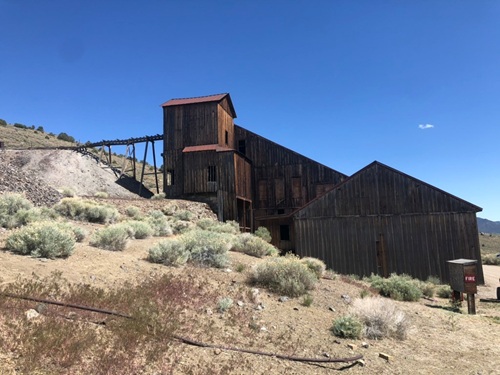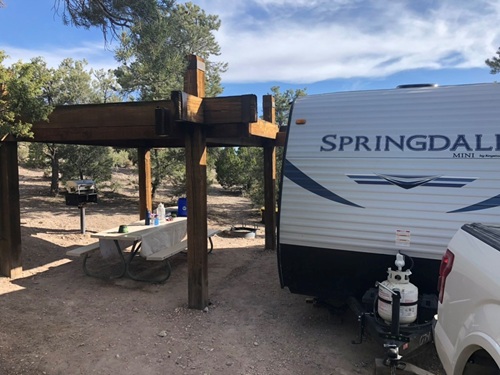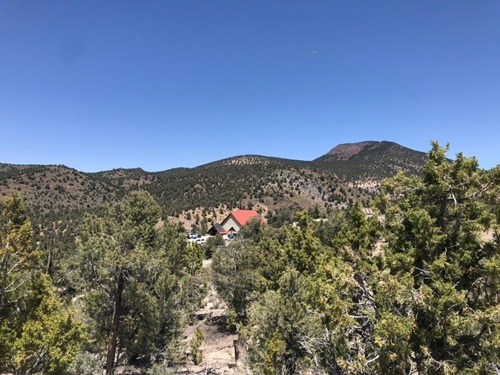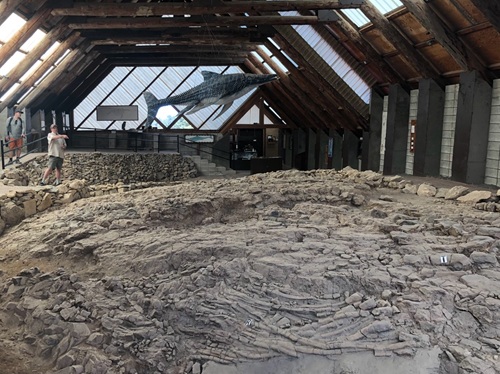
Great Basin Brewery is Reno’s most famous brewery, and their flagship offering is the piney, somewhat skunky “Icky IPA.” Tens of thousands of IPA lovers enjoy this beer every year without so much as glancing at the bottle’s label, which features an image of Nevada’s state fossil and the beer’s namesake, the Ichthyosaur, a class of extinct marine reptiles from the dinosaur era (though not technically a dinosaur if we’re being pedantic about it).
The reason the Ichthyosaur is Nevada’s state fossil is no doubt because Nevada has one of the largest preserves of Ichthyosaur fossils in the world. Today that preserve is located in Berlin-Ichthyosaur State Park, a waterless desert and one of the few human habitations (of a sort) for miles around – though millions of years ago it was deep under the ocean.
At just under three hours from Reno (160 miles), Berlin-Ichthyosaur State Park is the perfect weekend getaway, barring a few caveats. Trekking into central Nevada is a bit like stepping back in time. Fuel, food, lodgings and cell service get scarce outside of Fernley and Fallon. The distance back isn’t particularly long, but you’ll definitely want to refill your gas tank and water jugs in one of those towns. The desert isn’t a place to get lost with a quarter tank of gas and a small plastic water bottle. You might as well pack for camping, too – because the only place to stay in Berlin is the campground anyway – and if you aren’t planning on heading home in the evening (which is certainly doable), you’ll need to spend the night there.

Abandoned mill and mining buildings show a piece of the past in Berlin-Ichthyosaur State Park.
Berlin – the Ghost Town
After leaving Middlegate, you’ll eventually reach a turnoff that leads to the Berlin-Ichthyosaur State Park. The paved road gives way to gravel and dirt (though any regular car can handle it), and you enter Berlin – an assortment of mining and early industrial-age remains combined with the cabins of the park rangers, the only residents who live here full time.
Old mining buildings, their roofs and siding heavily worn, protrude from the hillside. Interpretive signs tell the story of the town’s rise in the late 1800s from a desert wasteland to a bustling mine with a few hundred full-time workers and then back to desert as it became uneconomical to mine there.
Farther ahead is the old mill, a massive wood building that still houses the remains of machinery that looks like it’s made of stone. In the age of silicon chips and artificial intelligence, it’s a reminder of how quickly life has changed in a little over 100 years.
From the mill, you’ll also catch sight of the rangers’ cabins, trucks, propane tanks and solar panels (it is entirely off-grid living here), and you may even see a few of them out and about.

Camping is primitive with no hookups, but there are toilets, non-potable water, grills and tables.
The Campground
Hopping back into the car and driving a bit farther, you’ll take a sharp turn after a couple miles, before you reach the Berlin-Ichthyosaur Campground on the right.
The campground is surprisingly nice for being in the middle of an extremely arid portion of the desert. There is ample tree coverage, and most of the campsites have awnings for shade. Though there are no hookups, there are toilets, non-potable water spigots, grills and tables. Booking is available online, but there tend to be extra campsites available year-round, outside of really busy holidays.
While the camp and the general area does not have a ton to keep you busy for days on end, it is a good place to visit for a night or two, and with the lack of any urban area for more than a hundred miles away, this is prime star-viewing country.
The Fossil Shelter
The fossil shelter is less than a mile beyond the campground, and you can hike to it via a short trail within the campground.
Pro Tip: If you’re going to visit the fossil shelter, it’s well worth it to be there for one of the tours. They aren’t overly long and elaborate, and they give you a good idea of what you are seeing at the fossil shelter. The tour times are 10 a.m. or 2 p.m., but the 2 p.m. option is better. The shelter can be a little dark and cold during the desert morning, so ideally you would see Berlin first before arriving for the 2 p.m. tour at the fossil shelter. Also, the 2 p.m. tour has better lighting, with the sun behind the building providing clear illumination of the fossil area.
Part of the reason that the tour is so important is that it’s a bit hard to see – without a strong imagination – the fossilized remains of the Ichthyosaur within the fossil quarry, but the tour guide can explain how they are positioned and the various theories about how they died in that location of the sea.

A short hiking trail leads from the campground to the Fossil Shelter.
The tour lasts less than an hour, and you are allowed to walk around the shelter afterward for as long as you like. It really gives insight into how complicated and arduous paleontology is – and what master puzzle solvers paleontologists are, in some cases spending decades to unravel the skeleton of a single animal.
The tour costs a mere $5 for adults and is free for kids. Day-use fees at the camp are $5, and camping is $15 per night, meaning that cost of gas is the only real price you pay to come out to enjoy Berlin-Ichthyosaur State Park. It’s certainly an amazing day trip or quick weekend getaway that everyone living in Reno should take at some point. And while Ichthyosaur may not have been dinosaurs, they’re close enough when you have dinosaur-obsessed kids who want to see some dinosaur-age fossils in their natural habit, far away from Hollywood movies and air-conditioned museums.

Inside the Fossil Shelter you can see fossilized Ichthyosaur remains. Rangers lead programs to help you understand what you're seeing.
Want to go?
Berlin-Ichthyosaur State Park
HC 61, Austin, Nevada
(775) 964-2440


 Dan Bablinskas is a relentlessly curious person with a passion for travel, foreign languages, affordable food and lodgings, well-fashioned cappuccinos and refreshing craft brews. After receiving his bachelor’s degree in creative writing, he traveled through Europe and South America while working as an English teacher and travel blogger. After trying a number of different careers, he settled into technical and content writing for his day job. In his spare time, he enjoys exploring the Reno-Tahoe area by foot, car, bike and ski. He lives in Reno with his wife and two kids.
Dan Bablinskas is a relentlessly curious person with a passion for travel, foreign languages, affordable food and lodgings, well-fashioned cappuccinos and refreshing craft brews. After receiving his bachelor’s degree in creative writing, he traveled through Europe and South America while working as an English teacher and travel blogger. After trying a number of different careers, he settled into technical and content writing for his day job. In his spare time, he enjoys exploring the Reno-Tahoe area by foot, car, bike and ski. He lives in Reno with his wife and two kids. 

